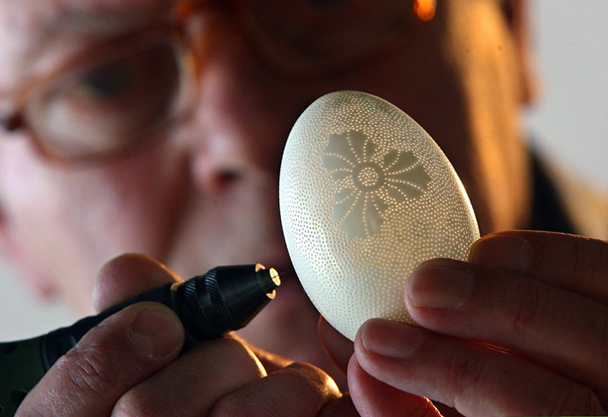With careful eye and steady hand, Franc Grom carves delicate eggshells into exquisite miniature sculptures. He works from a studio in his native village of Stara Vrhnika, near the Slovenian capital of Ljubljana, putting a high-tech twist on the national tradition of embellishing eggs at Eastertime.
In Slovenia, pirhi, meaning Easter eggs, are intricate works of art. Slovene artisans typically paint their eggs in elaborate detail, or—using what is known as the drsanka technique—lightly scratch delicate designs into the surfaces of colored eggs. “Making Easter eggs is a Slovene tradition, but carving them is an exception; it was my invention,” Grom explains. Those familiar with Slovene motifs and customs may recognize the national flower—the carnation—and the delicate lace patterns Grom “embroiders” with thousands of minute holes fashioned by a dental drill. As the accompanying slideshow illustrates, some of his sculptures render these inspirations quite realistically; others take the designs in a more contemporary direction.
Now 72, Grom has been carving for 18 years, and works at his craft year-round. “During the day I work for as long as I can concentrate, taking a couple of breaks. The concentration is important, as I drill the eggshell directly in my hands.” Grom notes that for maximum flexibility, he must hold the egg gently, creating a pillow in his palm, or the egg will begin to crack.
Grom needs to choose the eggs he works with very carefully, or he will literally be walking on eggshells. After many years, he has learned that the key is in what the hens eat: They need limestone in their diet to produce eggs with durable, resilient shells that stand up to his technique. Grom trusts local farmers to provide him with quality eggs. “I have been very careful for the last few years. I always check the egg under a strong light in advance before I begin carving. If I see a micro-crack in the shell, I don’t carve the egg. I know from experience that it will break.”
As is the case with traditional Slovenian Easter eggs, Grom starts his process by cleaning the eggs, poking holes in the top and bottom of the shell, and blowing out the liquid. Working with an empty, washed, and dried eggshell, Grom produces the designs for his eggs with the same spirit he uses in carving them: freehand, and with endless imagination. “I create the designs directly on the egg, drawing with a pencil,” Grom explains—he uses neither sketches nor a computer. He lightly etches the chosen image on the shell itself, his blank canvas.
Depending on the difficulty of the design, it may take him one to two weeks to carve a complete image on an eggshell. All the while, he is faced with the prospect that a crack might form and ruin the eggshell completely. Grom’s search for technology that would allow him to drill holes mere millimeters apart led him to stone-carving tools as well as a minuscule electric dental drill.
A typical Franc Grom egg will contain 2,000 to 3,000 holes, though the artist recalls an egg he worked on for nearly three months in 2010, fashioning approximately 24,000 holes. In addition to Slovenian lace and botanical motifs, he also carves specific designs upon request, such as the portrait of Che Guevara he created at a friend’s suggestion.
Besides being an Eastertime Internet curiosity, Grom’s eggs have been exhibited in Slovenia, India, Japan, and the United States, the artist reports. Grom has also occasionally given the eggs as gifts, to the Vatican and reportedly to collector and admirer Bill Clinton. Otherwise, Grom sells the eggs himself, starting at around $500 each, though prices vary depending on the difficulty of the design and number of holes. A certificate accompanies each egg indicating the number of holes it bears.
The finished, intricately carved shells glow when illuminated like porcelain statues. When asked how this idea of egg carving came about, the artist explains, “The idea just came into my mind. I was trying to improve this Slovenian tradition by making extra holes in the shell, so the new holes could show new pictures.” And now the whole world is taking notice.

